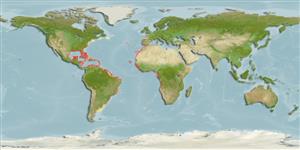Actinopterygii
辐鳍鱼纲 (条鳍鱼) >
Elopiformes (Tarpons and tenpounders) >
Megalopidae (Tarpons)
Etymology: Megalops: Greek, megas, megalos = great + Greek, ops = appearance (Ref. 45335). More on author: Valenciennes.
环境 / 气候 / 范围
生态学
; 海洋; 淡水; 半咸淡水 礁区鱼类; 非产卵性溯降河的 (Ref. 51243); 深度上下限 0 - 30 m (Ref. 3789), usually 0 - 15 m (Ref. 42064). , preferred 26°C (Ref. 107945); 49°N - 44°S, 99°W - 14°E (Ref. 55254)
Atlantic Ocean: from Nova Scotia, Bermuda and southward to Brazil in western Atlantic Ocean (Ref. 3234, 4446), where it it also found throughout the Gulf of Mexico and the Caribbean (Ref. 26938); from Mauritania to Angola in eastern Atlantic Ocean (Ref. 2845, 3234, 4446, 81266); with exceptional records in Portugal, Azores and Atlantic coast of southern France (Ref. 3234, 4446). It had crossed the Panama canal and was also caught at Coiba Island in the Pacific Ocean (Ref. 4446).
Length at first maturity / 大小 / 重量 / 年龄
Maturity: Lm 160.0, range 130 - 128.5 cm
Max length : 250 cm TL 雄鱼/尚未辨别雌雄; (Ref. 2683); common length : 130 cm TL 雄鱼/尚未辨别雌雄; (Ref. 2683); 最大体重: 161.0 kg (Ref. 26340); 最大年龄: 55 年 (Ref. 9975)
背棘 (总数): 0; 背的软条 (总数): 13-16; 臀棘 0; 臀鳍软条: 22 - 25; 脊椎骨: 53 - 57. Diagnosis: It is characterized by the anterior position of pelvic fin insertions in relation to dorsal-fin origin, and by some morphometric counts: 13-16 dorsal-fin rays, 40-48 lateral-line scales and 53-57 vertebrae (Ref. 2845, 81266).
Inhabit coastal waters, bays, estuaries, mangrove-lined lagoons, and rivers (Ref. 3789, 27188). Often found in river mouths and bays, entering fresh water (Ref. 27227). Large schools may frequent particular spots for years (Ref. 9710). Feed on fishes like sardines, anchovies, Mugilidae, Centropomus, Cichlidae (mainly those forming schools) and crabs (Ref. 3789, 27188). The swim bladder, attached to the esophagus, can be filled directly with air and permits the fish to live in oxygen-poor waters. Has high fecundity, a 203 cm female is estimated to produce over 12 million eggs (Ref. 10863). Spawn in waters which can be temporarily isolated from the open sea (Ref. 27188). Transparent leptocephalus larvae migrate into estuaries (Ref. 57533). Famous for its spectacular leaps when hooked. Marketed fresh or salted (Ref. 3789). Large scales are used in ornamental work and in preparation of artificial pearls (Ref. 3789). Used to be cultured commercially in Colombia (Ref. 7306). Highly appreciated by sport fishers. The flesh is also highly appreciated despite its being bony (Ref. 27188). The world record for hook and line is 283 lbs. from Lake Maricaibo, Venezuela (Ref. 13442).
Life cycle and mating behavior
成熟度 | 繁殖 | 产卵场 | 卵 | 孕卵数 | 仔鱼
Some populations may complete life cycle in freshwater, e.g. Lake Nicaragua in Central America, and Deep Lake in Florida (Ref. 4639).
Hureau, J.-C., 1984. Megalopidae. p. 226-227. In P.J.P. Whitehead, M.-L. Bauchot, J.-C. Hureau, J. Nielsen and E. Tortonese (eds.) Fishes of the north-eastern Atlantic and Mediterranean. UNESCO, Paris. Vol. 1. (Ref. 3234)
CITES (Ref. 94142)
Not Evaluated
人类利用
渔业: 商业性; 养殖: 商业性; 游钓鱼种: 是的; 水族馆: 公众的水族馆
工具
特别资料
下载 XML
网络资源
